You must have thought I had disappeared off the face of the Earth, but here I am, feeling very guilty for having deserted you for so long. So much has happened since I last wrote; but sadly we have only had a scattering of circles this year.
An early crop circle arrived on 22 June, just below the Hackpen chalk White Horse. This is an area in which we have had several wonderful crop circles over the years. It is one of the footholds of the Knights Templar.
We are told that ‘The Knights Templar were a powerful medieval military-religious order founded around 1119 to protect pilgrims in the Holy Land, becoming a significant military force during the Crusades. They accumulated vast wealth and land through donations and sophisticated financial management but fell from grace due to their wealth, power, and alleged heresy. In 1307, French King Philip IV had the Templars arrested, tortured, and forced to confess to false charges, ultimately leading to their official suppression in 1312.
The Knights Templar no longer exist in their original form, having been disbanded in the 14th century. However, modern organizations and groups, such as the Masonic Knights Templar, carry on their legacy by supporting Christian faith, engaging in charitable work, and promoting chivalric ideals, with the Portuguese being a potential historical link to the original order.’
Returning to the crop circle, it lay in barley in the field below the chalk White Horse, a simple but most welcome one. Sadly the farmer harvested it out within 24 hours.
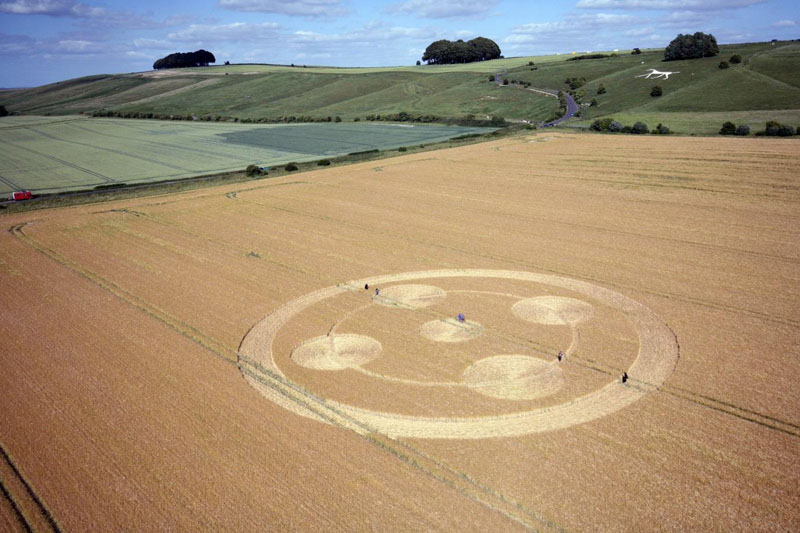
Hackpen Hill White Horse, near Winterbourne Bassett, Wiltshire - Copyright © Lucy Pringle
This whole area is one of special interest; it has a unique atmosphere or quality to it. It is called the Hackpen Ridge Way and, from a distance, you can locate it easily by the three enormous trees equidistant from each other, standing proudly against the skyline.
James Hussey and his family have farmed along these fields for several generations, and many have been the wondrous circles which have graced his land. There is a place where one can park at the top of Hackpen Hill, and one can feel the presence of one’s ancestors as soon as you get out of the car. As you walk along the farm track, you will come to a little wood on your left.
One year I took a group of Australians who did not mind if there were no circles; what they really wanted was to feel the energy of the places where circles had appeared regularly. On our way to the fields, we passed this little wood. To fully appreciate the energy, you have to visit it yourself. They were so enchanted by its special spirit, they felt they could have stayed there forever, and I had the greatest difficulty in moving them on to our next special place! We ended the tour in the last chamber of the ancient West Kennet Long Barrow, dating back to some 3650 BC. It consists of five chambers; the final and largest of the chambers had the unique quality of special and wonderful sound effects. This was the final destination of interest, especially as they had brought their crystal singing bowls with them. The music that came from their bowls in that very special place was completely magical, and we forgot the cares and worries that normally beset our lives and lost ourselves, listening with rapt attention to the heavenly music.
Moving on to this summer, an interesting circle was discovered further west than ever before, near Lyme Regis —
The name dates back to King Edward I, who granted the town a royal charter in 1284. Part of the name is after the River Lyn, which flows through the town. This royal designation was in return for the town’s promise to build warships and collect taxes, and was later confirmed by Queen Elizabeth I in 1591.
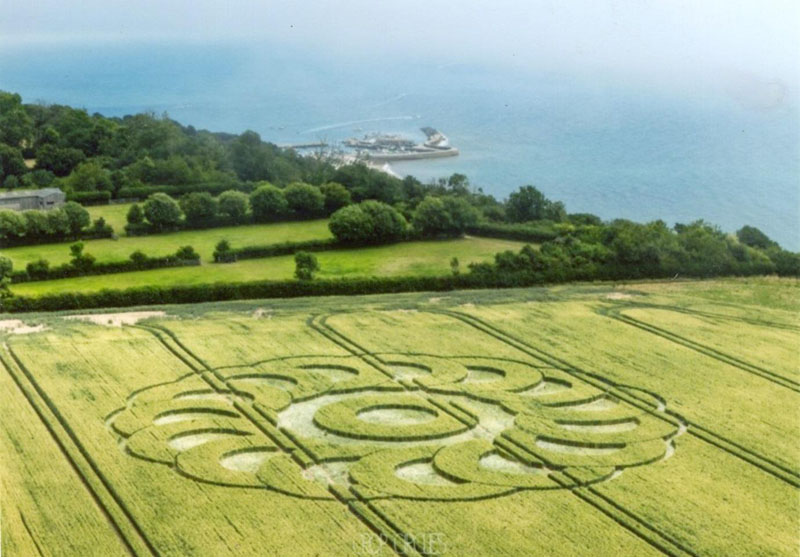
Ware Farm Manor, near Lyme Regis, Devon. 28th June. 170 feet (51.8 m) diameter. Wheat. This crop circle features central rings, surrounded by twelve overlapping crescent shapes arranged in a precise circular pattern, resembling interlocking petals or gears - Copyright © Nick Bull 2025 Stonehenge Dronescapes Photography
Several photographers took images and I love this one.
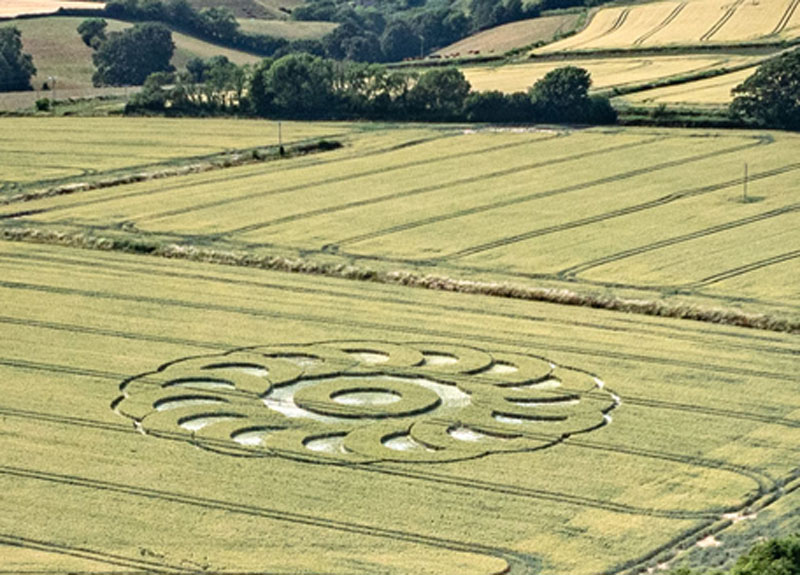
Copyright © 2025 Hugh Newman megalithomania.co.uk
Next came a large, symmetrical crop circle featuring the Triple Moon symbol, with two outward-facing crescent moons flanking a central full moon circle that contains a bold five-pointed star (pentagram). The design has small circular motifs at each end. 12th July 2025 ‘The triple moon symbol, often associated with feminine energy, represents the Triple Goddess in Wiccan and pagan traditions. It embodies the three phases of a woman’s life: Maiden, Mother, and Crone, which also correspond to the waxing, full, and waning phases of the moon. This symbol is used to honour the cyclical nature of life, femininity, and intuition.’
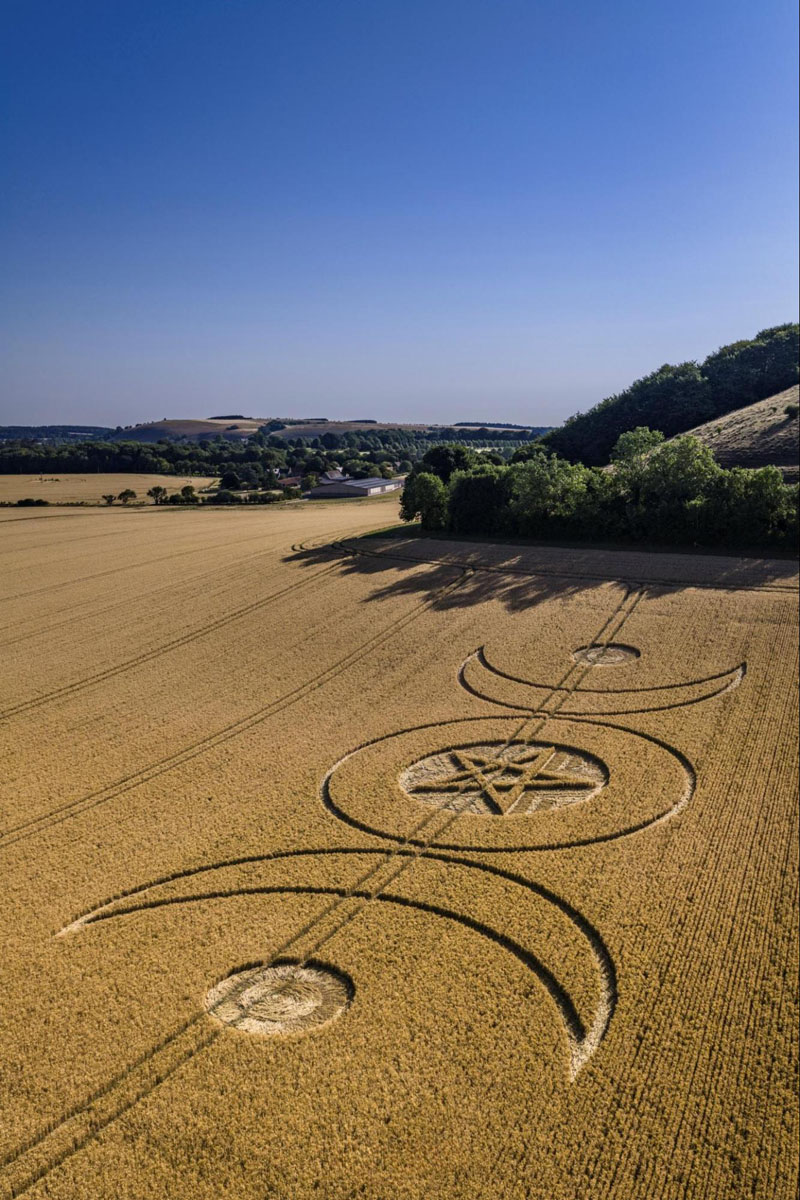
Copyright © Nick Bull 2025 Stonehenge Dronescapes Photography
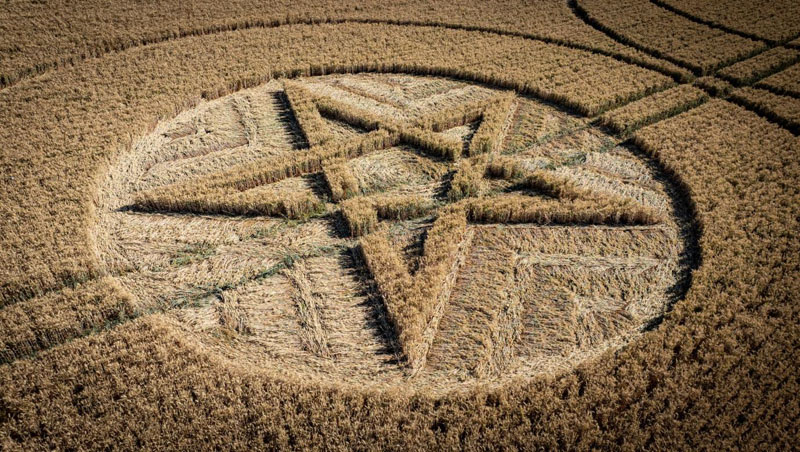
Beech Clump, near Ludwell, Wiltshire - Copyright © 2025 Hugh Newman megalithomania.co.uk
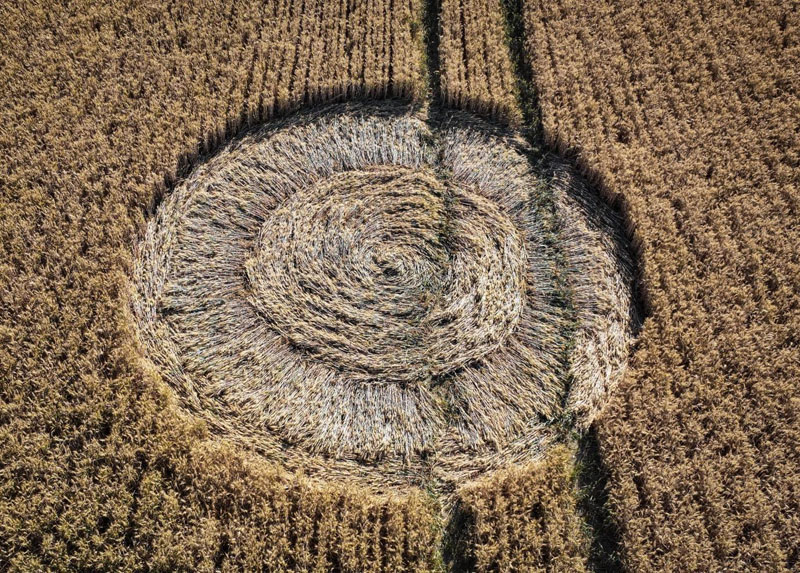
Beech Clump, near Ludwell, Wiltshire - Copyright © 2025 Hugh Newman megalithomania.co.uk
Not to be forgotten was a circle sent from Germany.
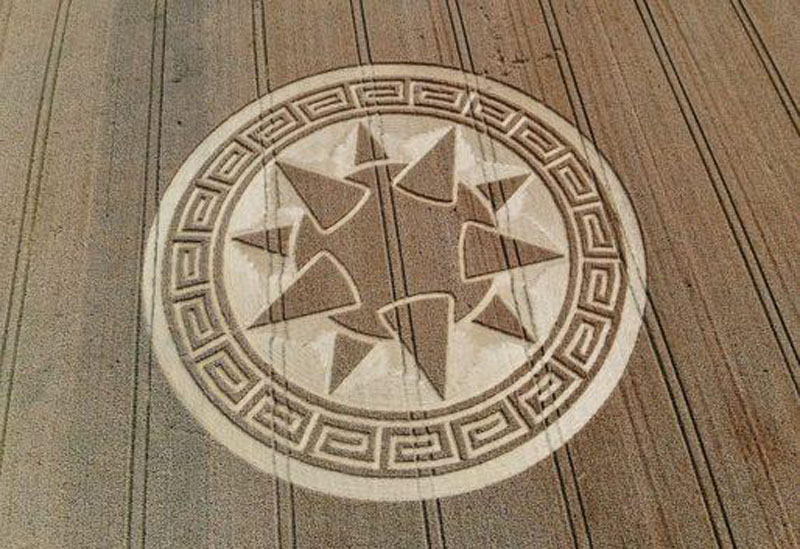
Frieding, near Andechs, Bavaria, Germany. A central circular motif resembling the head of a mace, bordered by a Greek ‘key’ design. Wheat. c.250 feet (76 m) 20th July 2025 - Copyright © Toni Bartl
First Tour
Both my tours were well overbooked, and if I take tours next year, those people who missed out this year will be notified.
By the time they were taking place, sadly there were no circles available. However, it turned out to have been one of the happiest and most instructive of any tours I have had the privilege of taking. It was a perfect day and we all met, as usual, at the Silbury Hill car park. As in other years, we got into as few cars as possible and parked in Avebury car park. From there, we walked to the main street where we were meeting Maria Wheatley, who took us round the stones enthralling us with her in-depth knowledge and understanding of the area and illustrating her talk with diagrams and photographs; she enchanted us with the magic of Avebury. I recommended bringing dowsing rods (these can easily be made from a pair of metal coat hangers). “For nearly 30 years, author and researcher, Maria Wheatley, has researched megalithic sites across the world. Maria is a second-generation dowser and geomancer who is the UK’s leading authority on the geodetic earth energies, ley lines and grid lines.
She has lectured worldwide and has shown the British Dowsers and other dowsing societies how to locate and find geodetic earth energies. Maria has worked alongside experts such as Rodney Hale to prove the existence of earth energies and how the stones can transmit electromagnetic energies.
Maria was the first independent researcher to track down and photograph the elongated (long-skulled) people of Stonehenge. Her exciting new finds regarding the long-lost people associated with the ancient monuments will soon be published in her forthcoming book, which will be a world first.
Maria has tracked down a unique priestesshood of Europe, the Bronze Age King or Priest that once ruled Avebury Henge, the Neolithic Queen of Stonehenge and has unearthed new finds that show us how and why certain monuments were constructed and used.”
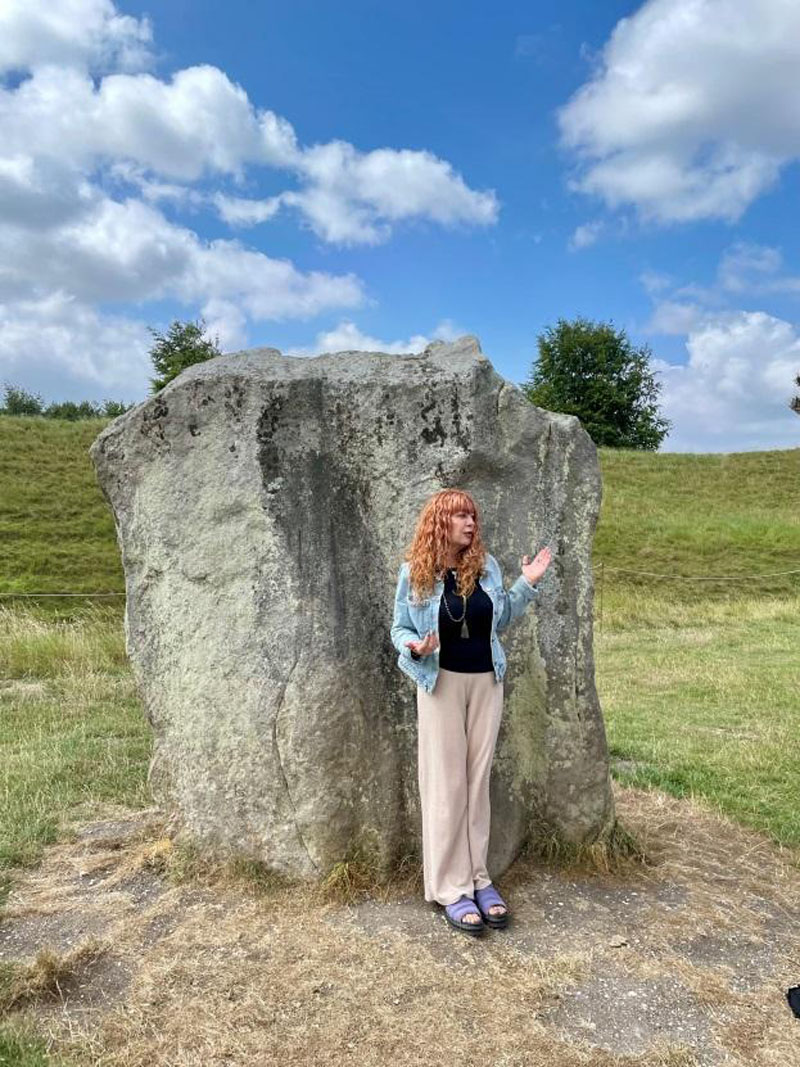
Maria Wheatley image - Copyright © Sonya Julia

Maria Wheatley and group - Copyright © Sonya Julia
Our Group


Measuring the bands of energy
Maria is a true professional, and we were all hanging on her every word and eagerly looking at the written details and pictures she had brought with her to illustrate her talk. The detailed years’ history of Avebury and the explanation of the different energies of the various stones — and how this can be measured. Sometimes this energy can reveal itself in different bands moving up from the base of the stones. We could test these bands of subtle energy moving up the stones, as the rods reversed at the different levels. In addition, we were shown the different healing areas of several stones.
After this special and uplifting experience, we had an enjoyable lunch at the Honey Street Café. When visiting the Honey Street complex of shops, there is another excitement, which is a ‘must’; it is the magnificent Crop Circle Exhibition, the soul and brainchild of Monique Klinkenberg. This is an experience not to be missed, as not only does it tell the history of the crop circles, but has the most extensive display of dazzling crop circle photographs to be found anywhere. Several years ago, Maria was captivated by the circles to such an extent that she sold her thriving business in the Netherlands and set up this amazing exhibition. Make sure you add it to your itinerary.
Tearing my group away, we next visited the famous and ancient West Kennett Long Barrow before gathering everyone’s cars from the Silbury Hill car park.
We made our way to the Stonehenge Visitors Centre, where I met several additional people who were not on the first part of the tour. We visited the most excellent exhibition before getting on the coach and making our way to the stones. As we drew closer, the stones appeared to be growing in size — nearer and nearer. As soon as the coach drew up, everyone rushed out. It is a very short walk from the coach to the stones and, as you approach them, you find you are not only marvelling at their size but feeling their energy as you get closer and closer to the giant megaliths.
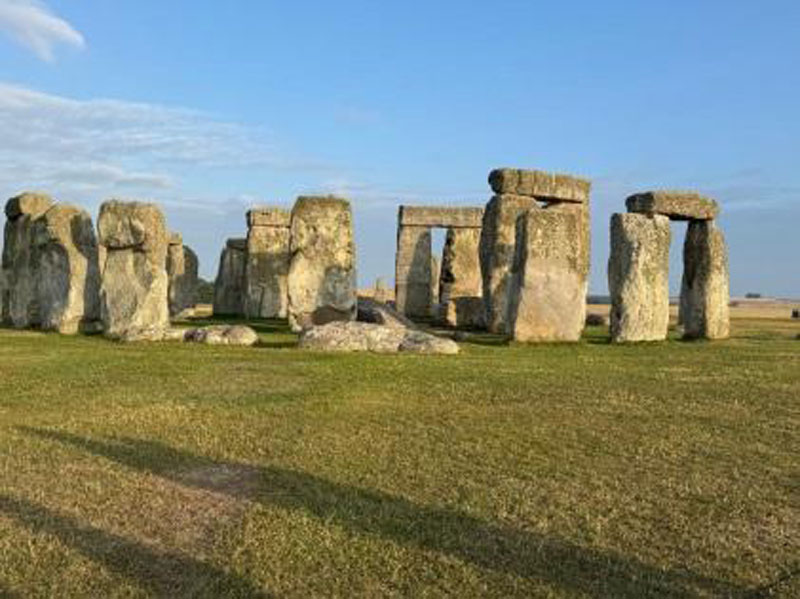
Stonehenge - Copyright © Sonya Julia

Stonehenge - Copyright © Sonya Julia
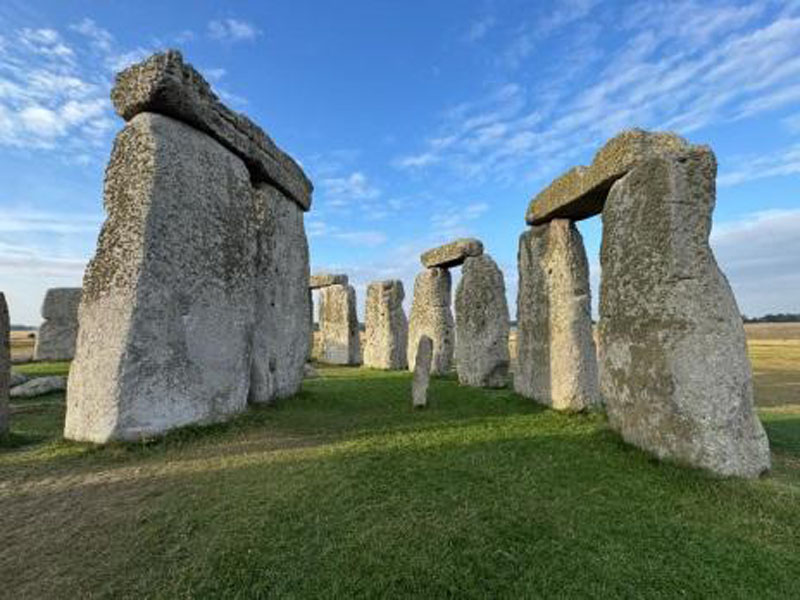
Stonehenge - Copyright © Sonya Julia
Over the years, I have taken many people to the stones, with several people having extraordinarily wonderful past-life experiences. This year, the weather was perfect and the stones seemed to be surrounded in a special ethereal light. We had an excellent guide, giving us an interesting and intriguing insight into our surroundings.
I am going to show you an amazing picture taken by Paul Stilwell of one of my group, Sonya Julia.
I was quite taken aback when I saw it, as it seemed to be all part of what many of us were experiencing.
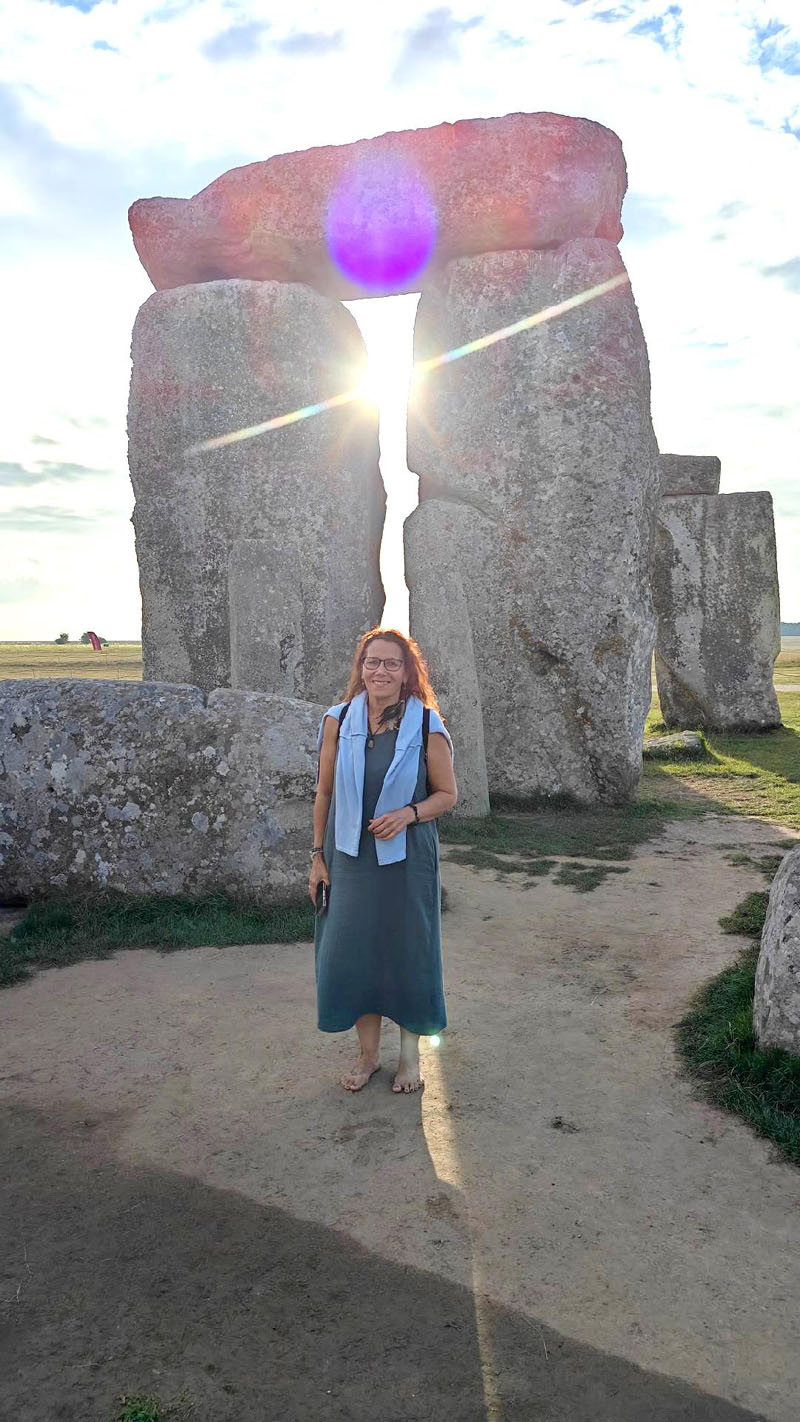
Sonya Young - Copyright © Paul Stilwell
To many people, the above picture may carry different meanings, and I received one (below) from a friend, David Olliff. I would love to hear what it may mean to you.
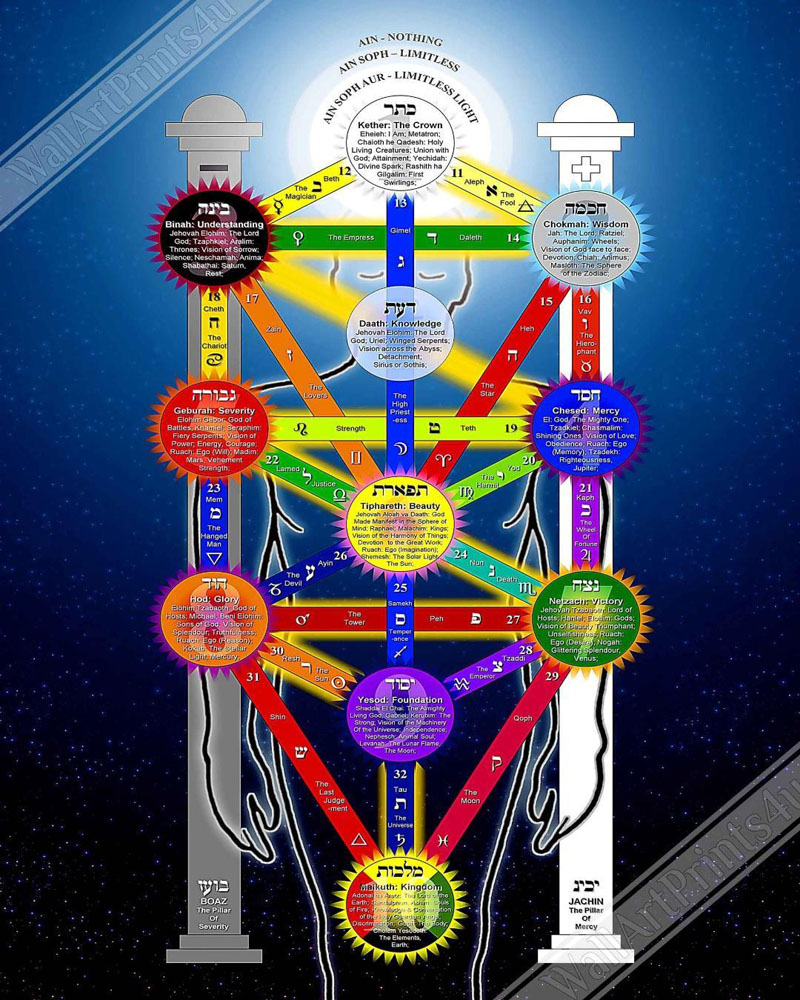
“Seeing the picture of your friend standing between two sarsen columns with the sun streaming through the gap, I was struck by the vivid purple coloured sphere perfectly positioned on the lintel. I have a tendency towards a kabbalistic interpretation of signs. For me, the colour and position of the sphere perfectly represented Yesod. Yesod, meaning Foundation, is the ninth sephirah on the Tree of Life. It is usually represented with the colour purple or violet. Each sephirah on the Tree of Life represents an aspect of the divine made manifest. There are ten of them, and they are often thought of as divine lights. Yesod is just one stage of creative manifestation prior to the physical kingdom. On the Tree of Life, Yesod is positioned between the twin pillars of divine Mercy and divine Strength. These are the pillars of Solomon’s Temple. For me, the purple sphere on the lintel above your friend’s head reveals the metaphysical structures which support creation. Just like the sarsens of Stonehenge seeming like a scaffold, holding up the entire cosmos.”
It was the end to a very happy day, and I had so many wonderful emails afterwards.
Second Tour
My second tour did not have an auspicious start, weather-wise. It was raining and continued raining and raining until just after lunch. Maria Wheatley had kindly agreed to take this second tour again. As before, we met Maria at 10.30. Maria is quite amazing and gallantly took us round, somehow adapting her talk with endless fascinating information despite the weather. ‘Did we want to continue?’ she asked, with rain dripping off her hood. So intrigued was everyone that, to a person, everyone said, ‘Yes, please continue.’ We were completely absorbed in everything she said and eagerly looking at all the illustrations and pictures which she had cleverly protected in plastic sleeves to keep them safe. She has a lovely sense of humour and, despite being thoroughly soaked, we all loved every moment.
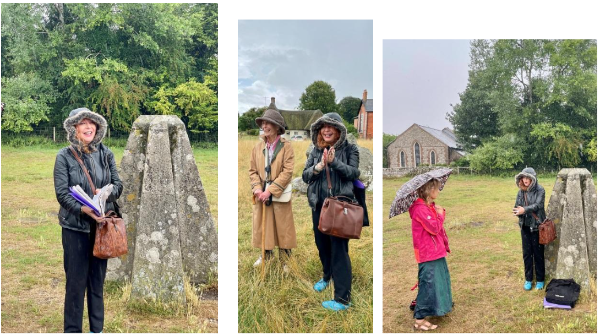
I wrote to her afterwards, as she had been truly magnificent; there are very few people who would have continued, unfazed and undaunted, with such tremendously fascinating information and good humour. Again, we hung on each new insight she shared, eagerly anticipating what might come next. What a professional.
I do really hope she might have some idea of what an invaluable contribution she made today.
As before, we went to lunch and warmed up at the Honey Street Café, followed by a visit to Monique’s wondrous exhibition. Instead of an evening visit to Stonehenge, there was the option of flying over the sacred area — Avebury Stone Complex, Silbury Hill, West Kennett Long Barrow — and also any nearby circles. There were the remains of an old circle which had been harvested, but it still showed up visibly and clearly. To the best of my knowledge; this is the first time in the history of the phenomenon that we did not have a crop circle in August.
I am hoping to take either one, or possibly two, tours next year. I will confirm that in the New Year.
As in previous years, highly specialised advanced clinical physiologist Paul Gerry again kindly agreed to conduct our annual scientific tests into the temporary relief of Parkinson’s disease and Essential Tremor.
I have received the results from the 6th July tests, but I would like further clarification on certain points. I will send the report in my next general letter.
Pam Gregory



























